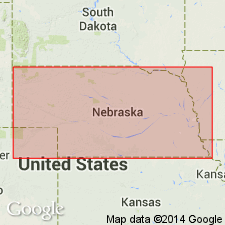
- Usage in publication:
-
- Falls City limestone member
- Modifications:
-
- Original reference
- Dominant lithology:
-
- Limestone
- AAPG geologic province:
-
- Forest City basin
Summary:
Pg. 9, 17, 30. Falls City limestone member of Admire(?) formation. Usually one massive bed, brownish mottled, soft, resinous; hardens on exposure. Thickness 3 feet to 6 feet 4 inches. Lies 18 to 27 [37?] feet above Aspinwall limestone. Fossiliferous (pelecypods). Age is Pennsylvanian. Report includes measured sections, cross sections.
Source: US geologic names lexicon (USGS Bull. 896, p. 718-719); GNC KS-NE Pennsylvanian Corr. Chart, sheet 1, Oct. 1936; supplemental information from GNU records (USGS DDS-6; Denver GNULEX).
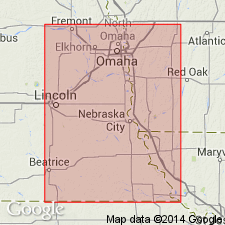
- Usage in publication:
-
- Falls City limestone bed
- Modifications:
-
- Principal reference
- Revised
- AAPG geologic province:
-
- Forest City basin
Summary:
Falls City limestone bed of Admire shale member of Wabaunsee formation. Named the beds overlying Falls City limestone and underlying Americus limestone the West Branch shale, and the beds underlying Falls City limestone the Aspinwall shale; but in 1932 he discarded Aspinwall shale and named the beds immediately below Falls City limestone the Hawxby shale. Age is Late Pennsylvanian (Missouri age). Report includes cross sections, measured sections, geologic maps, stratigraphic tables.
On p. 82 Condra stated type locality of Falls City limestone to be in Lehmer quarry, in sec. 32, T. 1 N., R. 16 E., 2.5 mi south and 1.5 mi west of Falls City, Richardson Co., NE.
Source: US geologic names lexicon (USGS Bull. 896, p. 718-719); GNC KS-NE Pennsylvanian Corr. Chart, sheet 1, Oct. 1936; supplemental information from GNU records (USGS DDS-6; Denver GNULEX).
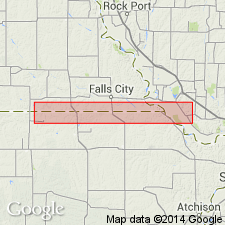
- Usage in publication:
-
- Falls City limestone formation
- Modifications:
-
- Revised
- AAPG geologic province:
-
- Forest City basin
Summary:
Pg. 5, 9. Falls City limestone formation of Admire group. At old Lehmer quarry, 4 miles southwest of Falls City and in lower course of Five Point Creek, includes (descending): Lehmer limestone member, 3 to 4 feet; Reserve shale member, 4.5 feet; Miles limestone member, 1+ feet. Overlies Hawxby shale formation and underlies West Branch shale formation, both of the Admire group. Age is considered Permian (lower part of Big Blue).
Source: Publication; GNC KS-NE Pennsylvanian Corr. Chart, sheet 2, Oct. 1936; US geologic names lexicon (USGS Bull. 1200, p. 1318).
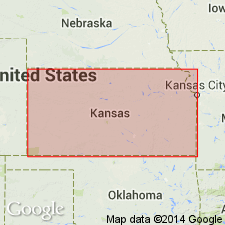
- Usage in publication:
-
- Falls City limestone*
- Modifications:
-
- Age modified
Summary:
Transferred all beds above Brownville limestone to Permian. (See "Modern classifications of the Pennsylvanian rocks of eastern Kansas and southeastern Nebraska," compiled by M.G. Wilmarth, Secretary of Committee on Geologic Names, USGS unpub. corr. chart, Oct. 1936, sheet 2.)
Source: US geologic names lexicon (USGS Bull. 896, p. 718-719); GNC KS-NE Pennsylvanian Corr. Chart, sheet 2, Oct. 1936.
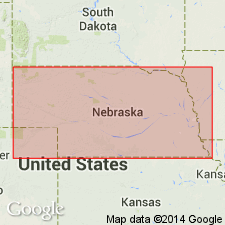
- Usage in publication:
-
- Falls City limestone member
- Modifications:
-
- Revised
- AAPG geologic province:
-
- Forest City basin
- Nemaha anticline
Summary:
Pg. 36 (fig. 14), 37. Falls City limestone member of Chicago Mound formation of Admire group. Rank reduced to member status in Chicago Mound formation (new). Includes Miles limestone, Reserve shale, and Lehmer limestone as beds. Thickness about 9 feet. Age is Permian (Big Blue).
Source: Publication; US geologic names lexicon (USGS Bull. 1200, p. 1318).
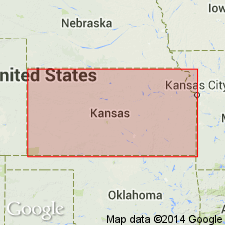
- Usage in publication:
-
- Falls City limestone*
- Modifications:
-
- Overview
Summary:
Pg. 52. Falls City limestone of Admire group. Underlies West Branch shale; overlies Hawxby shale. [Age is Early Permian (Wolfcampian).]
Source: US geologic names lexicon (USGS Bull. 1200, p. 1318).
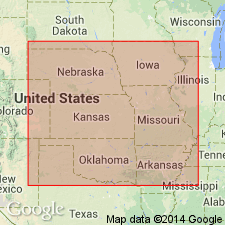
- Usage in publication:
-
- Falls City limestone*
- Modifications:
-
- Revised
Summary:
Pg. 2274 (fig. 1). Falls City limestone of Admire group. Underlies West Branch shale member of Janesville shale (new); overlies Hawxby shale member of Onaga shale (new). Age is Early Permian (Wolfcampian).
Source: US geologic names lexicon (USGS Bull. 1200, p. 1318).
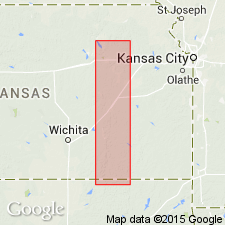
- Usage in publication:
-
- Falls City Limestone*
- Modifications:
-
- Biostratigraphic dating
- Areal extent
- AAPG geologic province:
-
- Chautauqua platform
- Cherokee basin
- Nemaha anticline
Summary:
Falls City Limestone of Admire Group. Overlies Onaga Shale and underlies Janesville Shale, both of Admire Group. Conodont species association indicates the ADETOGNATHUS-SWEETOGNATHUS-STREPTOGNATHODUS biofacies; nearshore marine depositional environment. Age is Late Pennsylvanian (late Gzhelian; STREPTOGNATHODUS BELLUS conodont zone).
Described from measured sections in Chautauqua, Greenwood, and Pottawatomie Counties, eastern Kansas, and Osage County, northern Oklahoma. (Locs. 1, 2, 3, A12, A15, A26.)
Source: Publication.
For more information, please contact Nancy Stamm, Geologic Names Committee Secretary.
Asterisk (*) indicates published by U.S. Geological Survey authors.
"No current usage" (†) implies that a name has been abandoned or has fallen into disuse. Former usage and, if known, replacement name given in parentheses ( ).
Slash (/) indicates name conflicts with nomenclatural guidelines (CSN, 1933; ACSN, 1961, 1970; NACSN, 1983, 2005, 2021). May be explained within brackets ([ ]).

